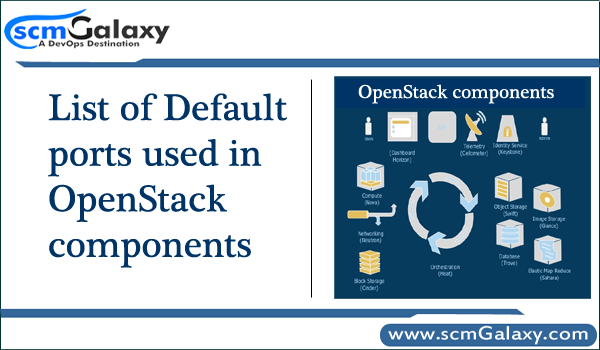
OpenStack service |
Default ports |
Port type |
|---|---|---|
| Block Storage (cinder) | 8776 | publicurl and adminurl |
| Compute (nova) endpoints | 8774 | publicurl and adminurl |
| Compute API (nova-api) | 8773, 8775 | |
| Compute ports for access to virtual machine consoles | 5900-5999 | |
| Compute VNC proxy for browsers ( openstack-nova-novncproxy) | 6080 | |
| Compute VNC proxy for traditional VNC clients (openstack-nova-xvpvncproxy) | 6081 | |
| Proxy port for HTML5 console used by Compute service | 6082 | |
| Identity service (keystone) administrative endpoint | 35357 | adminurl |
| Identity service public endpoint | 5000 | publicurl |
| Image Service (glance) API | 9292 | publicurl and adminurl |
| Image Service registry | 9191 | |
| Networking (neutron) | 9696 | publicurl and adminurl |
| Object Storage (swift) | 6000, 6001, 6002 | |
| Orchestration (heat) endpoint | 8004 | publicurl and adminurl |
| Orchestration AWS CloudFormation-compatible API (openstack-heat-api-cfn) | 8000 | |
| Orchestration AWS CloudWatch-compatible API (openstack-heat-api-cloudwatch) | 8003 | |
| Telemetry (ceilometer) | 8777 | publicurl and adminurl |
This table lists the ports that other OpenStack components use:
Service |
Default port |
Used by |
|---|---|---|
| HTTP | 80 | OpenStack dashboard (Horizon) when it is not configured to use secure access. |
| HTTP alternate | 8080 | OpenStack Object Storage (swift) service. |
| HTTPS | 443 | Any OpenStack service that is enabled for SSL, especially secure-access dashboard. |
| rsync | 873 | OpenStack Object Storage. Required. |
| iSCSI target | 3260 | OpenStack Block Storage. Required. |
| MySQL database service | 3306 | Most OpenStack components. |
| Message Broker (AMQP traffic) | 5672 | OpenStack Block Storage, Networking, Orchestration, and Compute. |
On some deployments, the default port used by a service may fall within the defined
